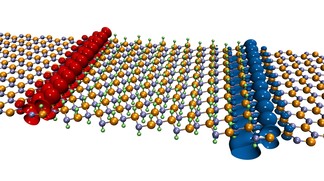EPFL researchers have showed that a few-atom wide electrical channel can be created within 2D insulating materials. The simulations open new areas for producing new photovoltaic and electronic devices.
 © 2014 EPFL
© 2014 EPFL
When two materials are artificially combined, in the nano world, surprising phenomenon may occur. Scientists at EPFL have shown that a conducting channel can be created with few-atom width in the contact zone between different insulating material sheets. This work can help create not just new nano- and micro-electronic devices but also new solar cells.
In order to create these small conducting channels, scientists studied 2D materials or material sheets few atoms thick, sometimes having only a single atom layer.
These materials similar to graphene contain atoms arranged hexagonally similar to beehive cells. The difference is that graphene is conductive and has carbon atoms, however the 2D materials are insulating and have different elements.
Researchers considered boron nitride(BN) among other possibilities as BN has two kinds of atoms. In its natural state, a BN sheet behaves like an insulator and is a bad conductor of electricity. However, after minor chemical modification the technique allows researchers to form “leads” for conductive electrons.
Electrical channel fabrication was done in two steps. It is made by arranging a proton on a boron nitride sheet above each boron atom and one below each boron atom. The boron nitride sheet is sandwiched between hydrogen atoms and generates a few atom-wide conductive channel when it contacts with a “pristine” BN sheet.
Taken separately, the chemically modified sheet and the blank sheet are not conductive. It is only by combining one with the other that the channel appears.
Giovanni Pizzi, co-author of the study
There are numerous applications possible with these simulations. Applications with regards to these small conductive channels can create new types of ultra-thin and flexible solar cells.
EPFL researchers anticipate that their simulation attracts the attention of experts in the experimental area for performing tests in real-life settings.
In our study we provide a simple calculation that researchers can perform to see if a given material, after chemical modification, will form these tiny wires. Our idea relies on previous results on 3D materials. We have also intentionally investigated existing experimental materials and techniques. This should facilitate experimental tests.
Marco Gibertini, co-authored the study
References